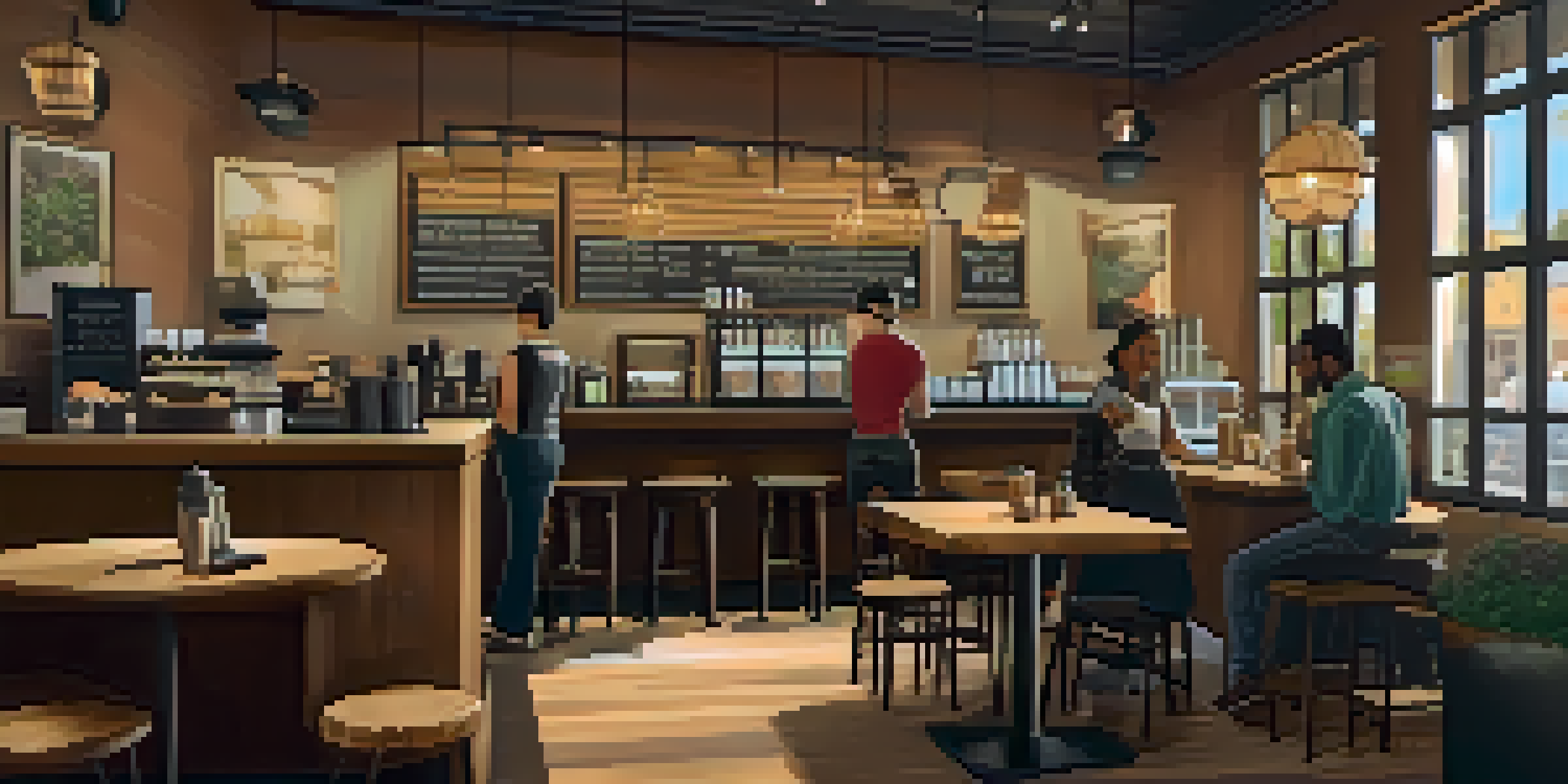The Rise of Starbucks: Seattle's Iconic Coffee Influence

The Humble Beginnings of Starbucks in Seattle
Starbucks started in 1971 as a single store in Seattle's Pike Place Market, selling high-quality coffee beans and equipment. Founded by Jerry Baldwin, Zev Siegl, and Gordon Bowker, the aim was to share their passion for coffee with the community. Initially, the focus was not on brewing coffee but on providing a unique experience around quality beans. This laid the foundation for what would later evolve into a global coffee phenomenon.
Coffee is a language in itself.
The name 'Starbucks' was inspired by Herman Melville's classic novel, Moby Dick, reflecting the founders' love for the sea and adventure. As they began sourcing beans from different regions, the company fostered relationships with coffee farmers, prioritizing quality and sustainability. This commitment to excellence set Starbucks apart from other coffee vendors of the time, enticing coffee enthusiasts to explore new flavors and origins.
In those early years, Starbucks was more than just a coffee shop; it was a gathering place for like-minded individuals who appreciated good coffee. This sense of community became a vital part of the brand's identity and paved the way for its expansion. As word spread about the quality of their products, Starbucks began to attract a loyal customer base, ready for what was to come.
Starbucks' Unique Coffee Culture and Experience
Starbucks revolutionized the coffee-drinking experience by creating a welcoming environment where people could relax, socialize, or work. The cozy ambiance, combined with comfortable seating and soothing music, encouraged customers to linger longer than they would in a typical café. This approach transformed coffee from just a beverage to a lifestyle choice, appealing to a broader audience.

The introduction of specialty drinks, such as the now-iconic Pumpkin Spice Latte, further solidified Starbucks' influence on coffee culture. These unique offerings not only attracted new customers but also encouraged the exploration of different flavor profiles. The seasonal menu became a much-anticipated event, fostering a sense of excitement and community around the brand.
Starbucks: A Global Coffee Icon
From its humble beginnings in Seattle, Starbucks has transformed into a global cultural icon, appealing to millions with its unique coffee experience.
Moreover, Starbucks embraced diversity by incorporating local flavors into its menu in various regions, making it feel more personalized to customers. This adaptability not only catered to different tastes but also showed a commitment to cultural inclusivity. As a result, Starbucks became synonymous with innovation, always pushing the boundaries of what a coffee experience could be.
Expansion: From Local Store to Global Empire
By the early 1990s, Starbucks began to expand beyond Seattle, opening stores in major cities across the United States. This growth was fueled by a strategic vision that emphasized consistency and quality, ensuring that customers could expect the same experience no matter where they were. Each new location was carefully chosen to maximize exposure and customer engagement.
The best part of waking up is coffee in your cup.
In 1996, Starbucks took its first steps into the international market with a store in Tokyo, Japan. This marked the beginning of a global journey that would see the brand flourish in various countries, each time adapting to local tastes while maintaining its core values. The ability to blend local flavors with its signature offerings became a hallmark of Starbucks’ expansion strategy.
Today, with thousands of locations worldwide, Starbucks is not just a coffee shop but a global cultural icon. Its presence in cities around the globe has made it a symbol of modern coffee culture, attracting millions of visitors each day. This remarkable growth story is a testament to the brand's ability to connect with people across diverse backgrounds.
The Role of Technology in Starbucks' Success
Technology has played a crucial role in Starbucks' evolution, enhancing customer experience and operational efficiency. The introduction of mobile ordering through the Starbucks app revolutionized the way customers interacted with the brand. This convenience allowed patrons to skip the line and have their favorite beverages waiting for them, creating a seamless experience.
Starbucks has also embraced loyalty programs, rewarding customers for their purchases and fostering brand loyalty. The Starbucks Rewards program encourages repeat business by offering perks like free drinks and exclusive promotions. This tech-savvy approach has resonated particularly well with younger demographics who appreciate the blend of convenience and rewards.
Commitment to Sustainability
Starbucks prioritizes sustainability through ethical sourcing and environmental initiatives, resonating with consumers who value responsible practices.
Additionally, Starbucks has leveraged social media to connect with its audience, sharing updates, promotions, and engaging content. This digital presence allows the brand to build a community around coffee lovers, enhancing customer relationships. By harnessing technology, Starbucks has successfully positioned itself as a forward-thinking leader in the coffee industry.
Sustainability Efforts: Brewing a Better Future
Starbucks has recognized the importance of sustainability in its operations, committing to ethical sourcing and environmental stewardship. The company sources coffee beans through its Coffee and Farmer Equity (C.A.F.E.) Practices, which ensure that farmers receive fair wages and operate sustainably. This initiative not only supports coffee-growing communities but also enhances the quality of the beans.
In addition to ethical sourcing, Starbucks has set ambitious goals to reduce its environmental footprint. Initiatives such as eliminating plastic straws and increasing the use of recyclable materials demonstrate the brand's commitment to sustainability. These efforts resonate with consumers who prioritize environmental responsibility, further solidifying Starbucks' place in the modern marketplace.
Moreover, Starbucks encourages customers to participate in its sustainability journey through initiatives like the Bring Your Own Cup program. This not only reduces waste but also fosters a sense of community among environmentally conscious consumers. By integrating sustainability into its core values, Starbucks is brewing a better future for both coffee lovers and the planet.
Starbucks and Community Engagement
Starbucks has always valued community engagement, aiming to create a positive impact wherever it operates. The company invests in local communities through initiatives such as the Starbucks Foundation, which supports various social causes. From education and youth programs to disaster relief efforts, Starbucks demonstrates a commitment to giving back.
In recent years, Starbucks has taken steps to promote inclusivity and diversity within its workforce. The company actively seeks to create a welcoming environment for employees from all backgrounds, fostering a sense of belonging. This commitment to diversity reflects the brand's values and resonates with customers who prioritize social responsibility.
Innovation Drives Customer Loyalty
By leveraging technology and introducing unique products, Starbucks enhances customer experiences and fosters brand loyalty among diverse audiences.
Additionally, store locations often serve as community hubs, hosting events and workshops that bring people together. From open mic nights to educational sessions, Starbucks encourages customers to connect and collaborate. By creating spaces for community interaction, Starbucks strengthens its ties with local neighborhoods and enhances its brand image.
The Future of Starbucks: Trends and Innovations
As Starbucks looks to the future, it continues to innovate and adapt to changing consumer preferences. The rise of plant-based diets has led to the introduction of non-dairy milk options, catering to a broader audience. This flexibility showcases Starbucks' commitment to meeting the diverse needs of its customers while staying relevant in the ever-evolving coffee landscape.
In addition, the brand is exploring new technology-driven trends, such as artificial intelligence and personalized marketing. These innovations aim to enhance customer experiences by offering tailored recommendations and efficient service. By staying ahead of the curve, Starbucks ensures it remains a leader in the coffee industry.

Looking forward, Starbucks is likely to continue expanding its global footprint while maintaining its focus on sustainability and community engagement. As coffee culture evolves, so will Starbucks, ensuring that it remains an integral part of consumers' lives. The brand's ability to balance innovation with its core values will be crucial in navigating the future of coffee.